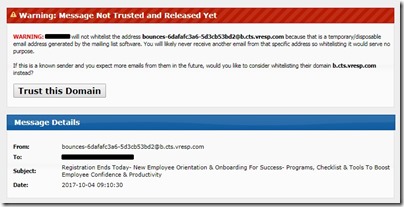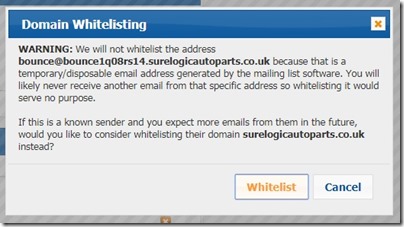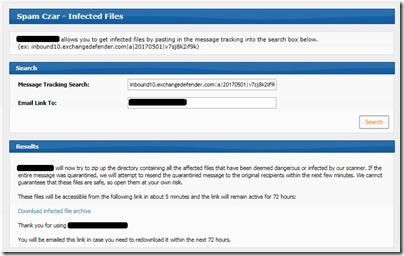ExchangeDefender Bounce Whitelisting & Quarantine Access
We’ve never invested as much as we have in 2017 when it comes to infrastructure and now that those massive upgrades are nearing completion, you’ll start seeing an avalanche of new features and services we’ve been working on all year starting to show up. I wanted to write this blog post to address one that is the largest piece of annoyance for our clients and that is whitelisting bounce emails and domains.
A little bit of background: Every time you see a bounce*@ email address is the last time you will see that address. These disposable, script generated addresses are only valid for a short period of time and are used by the mailing list companies to track bouncebacks and replies to their campaigns. On is generated for every single email sent out and if you look closely at them they usually have a random string or your email encoded in the user part of the email address. Whitelisting them, as so many people often try, is to put it simply: pointless. Naturally when the next email comes in from “the same sender” it’s going to have a completely different from address and the old whitelist entry will not fire. This tends to get really annoying really fast for clients that don’t understand what is going on behind the scenes.
To make things easier and assure delivery in the future, ExchangeDefender will now detect when you’re attempting to whitelist a bounce/disposable address and offer to whitelist the entire domain for you. We’ve stripped out the product branding so you can forward this to your clients or include in your own documentation/newsletter. When they click on a Trust link in an email report they will see this prompt:
And if they go through our online portal and attempt to whitelist a temporary bounce email, they will see this:
Is that all? Well, not quite. You see, most of these bounce lists are coming from legitimate sources such as Constant Contact, MailChimp, SalesForce, etc. Later this fall we will be releasing a new “Newsletter” feature but in the meantime our new managed whitelist (enterprise-wide) will make sure these bounce messages getting caught in SPAM folders due to their contents (but from legitimate sources) are no longer something your clients have to worry about fishing out. So yay, less work for everyone involved!
One more thing
While we’re on the “less work” train, infections and filename/filetype policy violations will no longer involve going through our team to release messages. You can now release infected or policy violating attachments/messages on your own through the Domain login at https://admin.exchangedefender.com. (psst. You can even let your clients / CIO types access this since it’s a domain-level feature, not an MSP-level feature)
Proceed with caution though, delegating access to this content is still a terrible idea though and please make sure you have adequate sandbox/antivirus/anti-rootkit software installed anywhere you download these. For every legitimate release request we get there are dozens of “No, my client does a lot of business with UPS and they definitely need that .exe that UPS emailed them.”
We hope these new features make you more productive and safer online. We’re really excited about everything else we have coming up!



